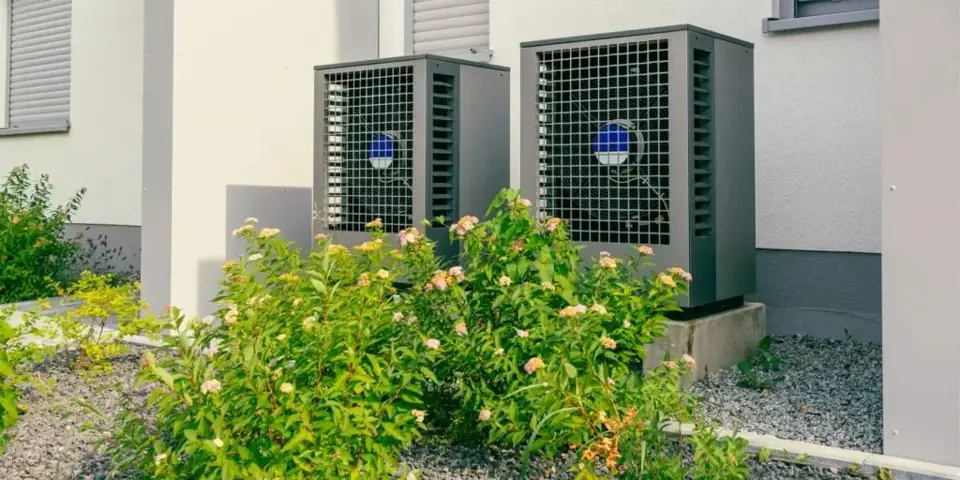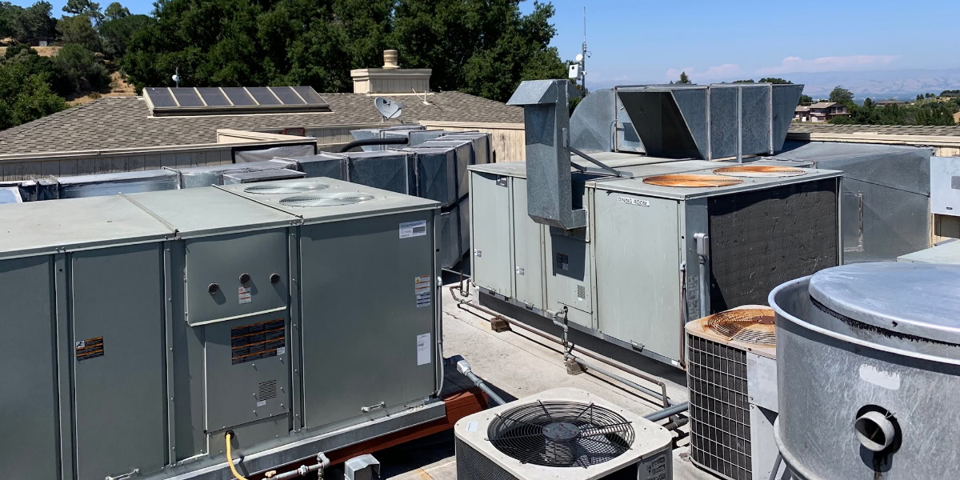When your commercial chiller starts showing signs of age—higher energy bills, frequent repairs, or inconsistent cooling—the immediate reaction might be to start shopping for a complete replacement. However, before you commit to a six-figure investment, consider this: chiller retrofits often deliver the same performance improvements at a fraction of the cost, with faster payback periods and less operational disruption.
At R&R Refrigeration and Air Conditioning, we’ve been helping Bay Area businesses optimize their HVAC systems since 1958. Through decades of experience serving San Francisco, Santa Clara County, San Mateo County, and Alameda County, we’ve seen countless cases where strategic retrofits delivered better ROI than full replacements. Let’s explore why chiller retrofits might be the smartest investment for your facility.
Understanding Chiller Retrofits vs. Full Replacement
A chiller retrofit involves upgrading specific components of your existing system rather than replacing the entire unit. This approach targets the most critical elements affecting performance, efficiency, and reliability while preserving the substantial investment you’ve already made in your infrastructure.
What Constitutes a Chiller Retrofit?
Chiller retrofits can range from simple component upgrades to comprehensive system overhauls. Common retrofit options include:
Control System Upgrades: Modern digital controls can transform an older chiller’s performance by optimizing operation based on real-time conditions, implementing advanced staging strategies, and providing detailed diagnostics.
Compressor Replacement: Installing new, high-efficiency compressors can dramatically improve energy performance while extending system life by decades.
Variable Frequency Drive (VFD) Installation: Adding VFDs to compressor and fan motors allows for precise speed control, reducing energy consumption by 20-40% in many applications.
Heat Exchanger Refurbishment: Cleaning, retubing, or upgrading heat exchangers can restore thermal efficiency to like-new levels.
Refrigerant System Updates: Converting to newer, more efficient refrigerants while upgrading associated components.
The True Cost of Full Chiller Replacement
Before diving into retrofit benefits, it’s crucial to understand the full scope of replacement costs. A new commercial chiller system involves far more than just the equipment price tag.
Direct Replacement Costs
- Equipment: $50,000 to $500,000+ depending on capacity and efficiency
- Installation Labor: $15,000 to $75,000
- Electrical Upgrades: $5,000 to $25,000
- Piping Modifications: $10,000 to $40,000
- Permits and Engineering: $3,000 to $15,000
Hidden Replacement Costs
- Business Disruption: Lost productivity during extended downtime
- Temporary Cooling: Rental equipment costs during installation
- Disposal Fees: Environmental disposal of old equipment
- Training: Staff education on new systems
- Warranty Gaps: Potential coverage issues during transition
The total cost of ownership for a new chiller system often exceeds initial estimates by 25-40% when all factors are considered.
The Economics of Chiller Retrofits
Retrofits offer compelling economic advantages that become even more attractive when you analyze the numbers carefully.
Upfront Cost Savings
Typical retrofit costs range from 30-60% of full replacement costs:
- Control System Upgrade: $15,000 to $50,000
- Compressor Replacement: $25,000 to $100,000
- VFD Installation: $10,000 to $30,000 per motor
- Combined Retrofit Package: $40,000 to $150,000
Faster Payback Periods
Because retrofit investments are lower while energy savings remain substantial, payback periods are typically 2-5 years compared to 7-12 years for full replacements.
Extended Equipment Life
Well-executed retrofits can extend chiller life by 15-20 years, maximizing the return on your original investment. This is particularly valuable for facilities with newer chillers (10-15 years old) that are experiencing efficiency degradation but have substantial remaining structural life.
Key Retrofit Technologies and Their ROI
Advanced Control Systems
Modern chiller controls are perhaps the most cost-effective retrofit option available. Today’s digital control systems offer capabilities that didn’t exist when older chillers were manufactured.
Benefits Include:
- Optimized staging and sequencing
- Real-time efficiency monitoring
- Predictive maintenance alerts
- Remote monitoring capabilities
- Integration with building management systems
Typical ROI: Control upgrades often pay for themselves within 2-3 years through improved efficiency and reduced maintenance costs. Energy savings of 10-25% are common, with additional savings from reduced service calls and faster troubleshooting.
Variable Frequency Drives (VFDs)
VFDs represent one of the highest-impact retrofit technologies available. By allowing motors to operate at variable speeds based on actual demand, VFDs eliminate the energy waste inherent in constant-speed operation.
Energy Savings Potential:
- Compressor VFDs: 15-30% energy reduction
- Condenser Fan VFDs: 20-40% fan energy reduction
- Chilled Water Pump VFDs: 30-50% pump energy reduction
Additional Benefits:
- Reduced mechanical stress on equipment
- Softer starts reducing electrical demand charges
- Improved temperature control
- Lower noise levels
ROI Considerations: VFD retrofits typically achieve payback periods of 2-4 years, with the fastest returns on applications with variable loads or extended part-load operation.
High-Efficiency Compressor Upgrades
Compressor technology has advanced significantly over the past two decades. Modern compressors offer improved efficiency, better capacity modulation, and enhanced reliability.
Performance Improvements:
- 15-25% efficiency gains over older compressors
- Better part-load performance
- Improved reliability and longer service life
- Enhanced capacity control
When to Consider: Compressor retrofits make the most sense when existing compressors are nearing end-of-life or when efficiency improvements can justify the investment through energy savings.
Retrofit vs. Replacement Decision Matrix
Choosing between retrofit and replacement requires careful analysis of multiple factors:
Favor Retrofits When:
- Equipment is 10-20 years old with good structural condition
- Energy costs are high (above $0.15/kWh)
- Cooling loads have decreased since original installation
- Budget constraints limit replacement options
- Minimal downtime is critical
- Existing infrastructure is adequate
Consider Replacement When:
- Equipment is over 25 years old
- Major structural components are failing
- Refrigerant is being phased out with no conversion path
- Cooling requirements have significantly increased
- Multiple major components need simultaneous replacement
- Long-term facility plans include major renovations
Environmental and Sustainability Benefits
Retrofits align with growing corporate sustainability initiatives and environmental regulations.
Reduced Environmental Impact
- Lower energy consumption reduces carbon footprint
- Extends equipment life, reducing manufacturing demand
- Minimizes waste from equipment disposal
- Often enables conversion to more environmentally friendly refrigerants
Regulatory Compliance
Many jurisdictions are implementing energy efficiency mandates for commercial buildings. Retrofits can help achieve compliance at lower cost than full replacement while demonstrating environmental stewardship.
Implementation Best Practices
Successful retrofits require careful planning and execution:
Assessment and Planning
- Comprehensive energy audit
- Load analysis and future projections
- Infrastructure evaluation
- Cost-benefit analysis of various options
Phased Implementation
Consider implementing retrofits in phases to:
- Minimize operational disruption
- Spread costs over multiple budget cycles
- Learn from initial phases to optimize later work
- Maintain system redundancy during upgrades
Professional Installation
Retrofit success depends heavily on proper installation and commissioning. Work with experienced contractors who understand both old and new technologies.
Financing Options for Retrofits
Several financing mechanisms can improve retrofit economics:
Utility Rebates and Incentives
Many Bay Area utilities offer substantial rebates for efficiency improvements:
- PG&E’s Customized Retrofit Program
- Local municipal utility incentives
- PACE financing options
Energy Service Company (ESCO) Partnerships
ESCOs can provide turnkey retrofit solutions with guaranteed savings, often with no upfront capital required.
Equipment Leasing
Leasing arrangements can provide immediate cash flow benefits while preserving capital for other investments.
Common Retrofit Challenges and Solutions
Integration Issues
Challenge: Ensuring new components work seamlessly with existing systems.
Solution: Thorough compatibility analysis and proper system commissioning.
Downtime Concerns
Challenge: Minimizing operational disruption during upgrades.
Solution: Careful scheduling, phased implementation, and temporary cooling solutions when necessary.
Performance Verification
Challenge: Confirming that retrofits deliver promised benefits.
Solution: Comprehensive monitoring and measurement protocols with baseline establishment.
The Future of Chiller Retrofits
Emerging technologies are making retrofits even more attractive:
IoT and Smart Controls
Internet of Things (IoT) sensors and cloud-based analytics are enabling unprecedented optimization of existing equipment.
Advanced Refrigerants
New refrigerant options provide opportunities to improve efficiency while meeting environmental regulations.
Modular Upgrades
Manufacturers are developing retrofit-specific components designed for easy integration with existing systems.
Conclusion
Chiller retrofits represent a compelling alternative to full system replacement, offering substantial cost savings, faster payback periods, and significant performance improvements. For many Bay Area facilities, retrofits can deliver 70-90% of the benefits of new equipment at 40-60% of the cost.
The key to retrofit success lies in proper assessment, strategic component selection, and professional implementation. When executed correctly, retrofits can extend equipment life by decades while dramatically improving efficiency and reliability.
As energy costs continue to rise and environmental regulations become more stringent, the economic case for retrofits will only strengthen. Facilities that act now can capture immediate savings while positioning themselves for long-term success.
Ready to explore retrofit options for your facility? R&R Refrigeration and Air Conditioning has been helping Bay Area businesses optimize their HVAC systems since 1958. Our experienced team can assess your current equipment, identify the most cost-effective upgrade options, and deliver professional installation with minimal disruption to your operations.
Serving San Francisco, Santa Clara County, San Mateo County, and Alameda County, we understand the unique challenges and opportunities in our local market. Contact us today for a comprehensive retrofit assessment and discover how much you could save while improving your system’s performance and reliability.
Frequently Asked Questions about Chiller Retrofits
Most chiller retrofits can be completed in 1-3 weeks, depending on the scope of work. Simple control upgrades might take just a few days, while comprehensive retrofits involving multiple components could require 2-4 weeks. We work closely with facility managers to schedule work during low-demand periods and minimize operational disruption.
A well-executed retrofit can extend a chiller’s life by 15-20 years, often matching or exceeding the remaining useful life of a new unit. The key is ensuring that major structural components (like the shell and tubes) are in good condition before retrofitting. With proper maintenance, retrofitted chillers can operate reliably for decades.
Yes, many older chillers can be converted to use newer refrigerants, though this requires careful analysis of system compatibility. Some conversions are straightforward, while others may require additional component upgrades. We evaluate each system individually to determine the most cost-effective approach for refrigerant conversion.
The best candidates for retrofit are typically 10-20 years old with good structural condition but declining efficiency. Key indicators include rising energy costs, frequent minor repairs, and outdated controls. We perform comprehensive assessments including efficiency testing, structural evaluation, and cost-benefit analysis to help you make the best decision.
Energy savings vary based on the age and condition of your existing equipment and the scope of retrofits performed. Typical savings range from 15-40%, with some comprehensive retrofits achieving even higher savings. Control system upgrades alone often provide 10-25% savings, while VFD installations can reduce energy consumption by 20-40% in variable-load applications.






